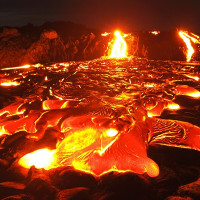Volcanic eruption products typically contain liquids, crystals, and insoluble gases that have never before reached the surface of the Earth.
“Magma” is “molten rock, normally located within magma cavities near the Earth’s surface”. Magma is a mixture of liquid silicates at high temperature and pressure and is the primary source of all igneous rocks. It has the ability to penetrate rock layers of adjacent crust or erupt to the surface.
Magma exists at a temperature range of 650 to 1,200°C. Magma is under high pressure in the ground and when it erupts to the surface through craters in the form of lava and pyroclastic flows. Volcanic eruption products typically contain liquids, crystals, and insoluble gases that have never before reached the surface of the Earth.

Magma exists at a temperature range of 650 to 1,200°C.
Magma is concentrated in many separate magma cavities in the Earth’s crust and has a significantly different composition in different areas, it can be found in subduction zones, faults or ridges. mid-ocean or on hot spots containing hot rock plumes of the mantle.
The formation of magma can only take place under some special conditions in the Earth’s asthenosphere. Magma can also be formed by the addition of volatile substances to heated rock.
Volatile substances are released from the subduction plates of oceanic crust, which penetrate the rock layers above and stimulate melting. They can break mineral bonds inside molten rock and cause the melting temperature to drop to form magma.
The formation of magma can also be the result of melting crustal rock because pre-existing magma is so hot that it melts the crustal rock as well. as it rises, this creates even more magma.

Magma warns of volcanic eruption.
The composition of magma varies depending on the composition of the underlying rock, which melts as the magma penetrates the Earth’s crust and is ejected in the form of lava. There are three basic forms of magma: Mafic, aldehyde, and felsic.
Magma is a mixture mainly of silica, alkaline and alkaline earth substances (sodium, potassium, calcium, magnesium) and iron. In general, the more mafic the magma, the smoother the eruption. This is because the high silica content causes volatiles to accumulate and can create explosive eruptions common in complex volcanoes.

